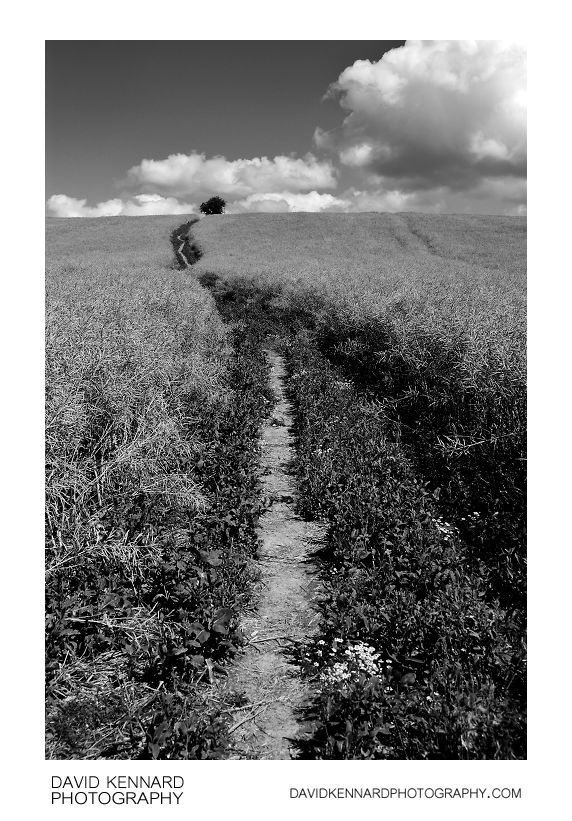Path through oilseed rape field on Lubenham Hill

Description
- Title:
- Path through oilseed rape field on Lubenham Hill
- Caption / Description:
-
Looking east up a path through a field of oilseed rape on Lubenham Hill in Market harborough, Leicestershire, UK.
From Wikipedia (http://en.wikipedia.org/wiki/Oilseed_rape):
Rapeseed (Brassica napus), also known as rape, oilseed rape, rapa, rappi, rapaseed and (in the case of one particular group of cultivars, canola) is a bright yellow flowering member of the family Brassicaceae (mustard or cabbage family). The name derives from the Latin for turnip, rāpum or rāpa, and is first recorded in English at the end of the 14th century. Older writers usually distinguished the turnip and rape by the adjectives round and long(-rooted) respectively.
In agriculture, canola are certain varieties of rapeseed oil, or the oil produced from those varieties. Canola is a trademark for a hybrid variety of rape initially bred in Canada. Rapeseed oil was produced in the 19th century as a source of a lubricant for steam engines, and the oil has a bitter taste due to high levels of acids. Canola has been bred to reduce the amount of acid, yielding a more palatable oil.
Rapeseed is grown for the production of animal feed, vegetable oil for human consumption, and biodiesel; leading producers include the European Union, Canada, the United States, Australia, China and India. In India, it is grown on 13% of cropped land. According to the United States Department of Agriculture, rapeseed was the third leading source of vegetable oil in the world in 2000, after soybean and oil palm, and also the world's second leading source of protein meal, although only one-fifth of the production of the leading soybean meal.
- Tags / Keywords:
-
- Europe
- UK
- Britain
- England
- East Midlands
- Leicestershire
- Market Harborough
- Biota
- Life
- Vitae
- Eukaryota
- Plantae
- Plants
- Magnoliophyta
- Flowering Plants
- Angiosperms
- Magnoliopsida
- Dicotyledons
- Brassicales
- Brassicaceae
- Mustard
- Cruciferae
- Crucifers
- Brassica
- Brassica napus
- Rapeseed
- Oilseed rape
Admin
- Date Original Photo Taken:
- Original File Name:
- _DSC9521a.NEF
- Event:
- Rating:
- ☆☆
- Date this image added/last updated on website:
- Original File Dimensions:
- 2592px x 3872px
- File Type:
- JPEG
- Color Mode:
- RGB
- Original Image Color Profile:
- Nikon Adobe RGB 4.0.0.3000
Location
- Location Shown:
-
- Sublocation:
- Lubenham Hill
- City:
- Market Harborough
- Province/State:
- Leicestershire
- Country:
- United Kingdom
- World Region:
- Europe
- Location Created:
-
- Sublocation:
- Lubenham Hill
- City:
- Market Harborough
- Province/State:
- Leicestershire
- Country:
- United Kingdom
- World Region:
- Europe
- Geo-location:
- 52.477776952278, -0.94630738088889 View on map
Rights
- Copyright Status:
- Copyrighted
- Licensing Status:
- Rights Managed
- Available for Editorial Use:
- Yes
- Available for Commercial Use:
- No
- Copyright Notice:
- © 2010 Dave Kennard
Camera Data
- Date Digital Resource was created:
- Shutter speed:
- 1⁄180 s
- Aperture:
- f/8
- Camera Model:
- Nikon D200
- ISO:
- 100
- Exposure Compensation:
- 0
- Focal Length:
- 29mm
- Focal Length (35mm equiv.):
- 43mm
- Metering Mode:
- Multi-segment
- Flash:
- No Flash
- Exposure Mode:
- Auto
- White Balance:
- Manual
- Light Source:
- Cloudy
- Exposure Program:
- Aperture-priority AE
Additional shooting metadata
- Lens:
- Nikon AF-S DX Zoom Nikkor ED 18-70mm F3.5-4.5G(IF)
- Filters used:
-
- B+W UV 010 MRC
- Additional Optics used:
- Setup:
- Handheld
Post Processing
- Image Modified:
- Software used:
-
- Nikon Capture NX 2
- Post Processing:
Curves adjustment in CNX2 to increase contrast
Curves adjustment in multiply blend mode selectively applied in CNX2 to darken sky
LCE applied in CNX2
Black & White conversion filter applied in CNX2
